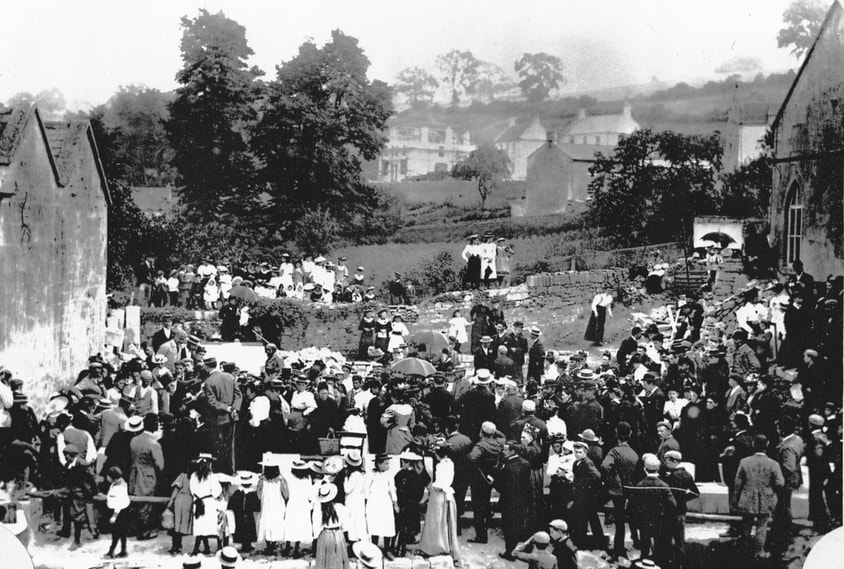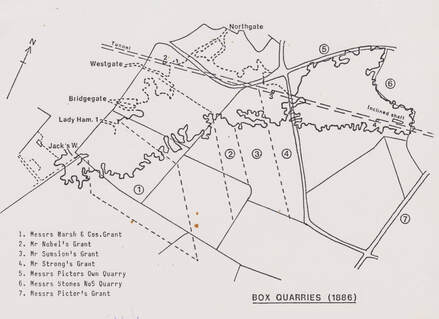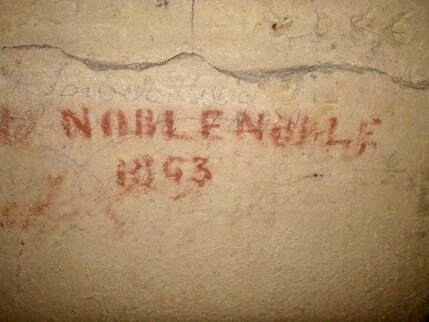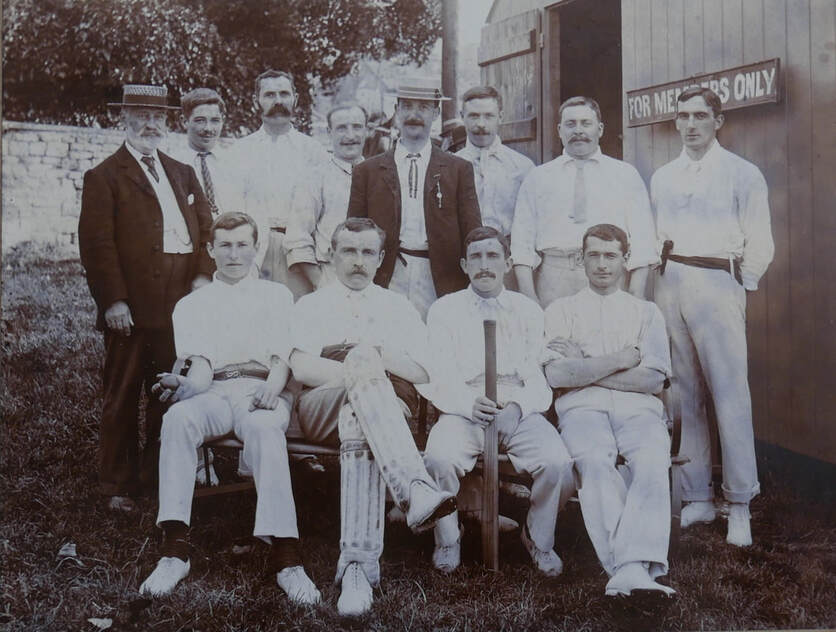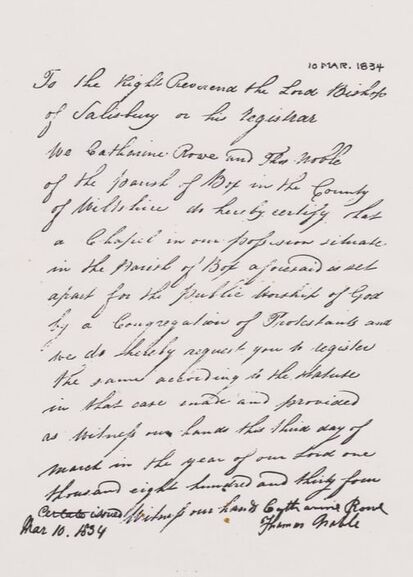The Noble Family: Box Quarry Masters Alan Payne August 2021
The Noble family gave their name to one of the local quarries but they, and their in-laws the Rowe family, were much more important than that in Box’s history. These two families virtually took over and created the centre of the village and influenced its spiritual life for ever with the building of the Methodist Church and the development of Chapel Lane.
Rowe and Noble Origins
The Rowe and Noble families weren’t originally from Box; Thomas Noble (1805-11 July 1867) was from Batcombe, Somerset, and Elizabeth Rowe (1811-) from Freshford, Somerset. Thomas Noble had a variety of jobs: referred to as tea-dealer in 1841, grocer in 1851 and as baker and grocer in 1861. However, it appears that it was Thomas’ mother-in-law, Catherine Rowe (1786-1855) also from Freshford, who was the skilled baker and had the family money. She was named as the head of the household in 1851. Thomas Noble didn’t come to Box for a career.
We understand more from the Rowe family, who appear to have been on a mission to offer John Wesley’s preaching to Box village. Freshford was an active centre of Methodism and Wesley himself opened their chapel in 1783, mentioning the village in his journal and preaching there several times. In 1757 the village had as many dissenting members as the whole of Bath.
In 1841 they all lived in The Barracks (possibly Box Workhouse), near the churchyard. In 1851 and 1861, they were listed between the Queen’s Head and The Manor House. At first glance their house seems to be Millers on the High Street, but more probably it was at Woodstock. The reason for suggesting this is the names of domestic servants and assistants (mostly the Cullen and Smith families) were recorded at Woodstock Cottages in the 1840 Tithe Apportionment records.
Samuel Rowe Noble, Quarry Owner
Samuel Rowe Noble (1833-1904) was the son of Thomas and Elizabeth who married into the quarrying industry when in 1864 he wed Elizabeth Pictor, the fourth daughter of Job Pictor, founder of Pictor & Sons of Clift Quarry. He was a stone merchant, buying and selling quantities of building material, possibly as early as 1860s (picture courtesy Mark Jenkinson) and his daughter was called stone merchant’s daughter in 1871.
Rowe and Noble Origins
The Rowe and Noble families weren’t originally from Box; Thomas Noble (1805-11 July 1867) was from Batcombe, Somerset, and Elizabeth Rowe (1811-) from Freshford, Somerset. Thomas Noble had a variety of jobs: referred to as tea-dealer in 1841, grocer in 1851 and as baker and grocer in 1861. However, it appears that it was Thomas’ mother-in-law, Catherine Rowe (1786-1855) also from Freshford, who was the skilled baker and had the family money. She was named as the head of the household in 1851. Thomas Noble didn’t come to Box for a career.
We understand more from the Rowe family, who appear to have been on a mission to offer John Wesley’s preaching to Box village. Freshford was an active centre of Methodism and Wesley himself opened their chapel in 1783, mentioning the village in his journal and preaching there several times. In 1757 the village had as many dissenting members as the whole of Bath.
In 1841 they all lived in The Barracks (possibly Box Workhouse), near the churchyard. In 1851 and 1861, they were listed between the Queen’s Head and The Manor House. At first glance their house seems to be Millers on the High Street, but more probably it was at Woodstock. The reason for suggesting this is the names of domestic servants and assistants (mostly the Cullen and Smith families) were recorded at Woodstock Cottages in the 1840 Tithe Apportionment records.
Samuel Rowe Noble, Quarry Owner
Samuel Rowe Noble (1833-1904) was the son of Thomas and Elizabeth who married into the quarrying industry when in 1864 he wed Elizabeth Pictor, the fourth daughter of Job Pictor, founder of Pictor & Sons of Clift Quarry. He was a stone merchant, buying and selling quantities of building material, possibly as early as 1860s (picture courtesy Mark Jenkinson) and his daughter was called stone merchant’s daughter in 1871.
Samuel wasn’t a substantial quarry-owner but there is evidence that he did lease one seam of stone from the Northey family in 1888.[1] Noble’s Quarry was accessed through the Westgate entrance almost directly above the railway tunnel.[2] It was an adit quarry, entered on the level directly into the side of a cliff.[3] It was regrettably blocked and ruined by tipping in the 1960s and 70s. Samuel didn’t seem to see himself as a quarry-owner and, for most of his life, referred to his trade as a dealer in stone, rather than as an extractor. In 1871 he called himself stone merchant employing 14 men; in 1881 farmer of 44 acres and stone merchant. By 1891 he was a farmer and baker and by 1901 he described his life as retired stone merchant.
Samuel became both socially important and financially wealthy in the Box area. He was appointed an Overseer of the Poor in 1866, a member of the local Grand Jury (deciding if there was sufficient evidence for prosecution of legal cases) in 1868, one of the founders of the Box Cricket Club in 1870 and deputy member of the Box School Board in 1871.[4] Noble’s Quarry was one of the seven local firms which amalgamated to form the Bath Stone Firms in December 1887. Profits had been uncertain and Noble was one of the few to still be in private ownership, not a limited company.[5]
In later years, especially after retiring from the quarry industry, he took to farming and by 1889 he was selling substantial numbers of young cattle at Devizes Market.[6] The family appear to have owned various properties in the village and to have tenanted others to suit their lifestyle. In 1871 they lived near Steam Mills in the Market Place. In the census records of 1881 and 1891, he and Elizabeth lived at Manor Farm and by 1901 they had moved back to the Market Place at Frogmore House. On his death in 1904, they were at Lorne Villa, where the family remained thereafter until the house was rented by the Awdry family.
In later years, especially after retiring from the quarry industry, he took to farming and by 1889 he was selling substantial numbers of young cattle at Devizes Market.[6] The family appear to have owned various properties in the village and to have tenanted others to suit their lifestyle. In 1871 they lived near Steam Mills in the Market Place. In the census records of 1881 and 1891, he and Elizabeth lived at Manor Farm and by 1901 they had moved back to the Market Place at Frogmore House. On his death in 1904, they were at Lorne Villa, where the family remained thereafter until the house was rented by the Awdry family.
|
Rebuilding the Methodist Chapel
Samuel became a pillar of the establishment: a supporter of John Poynder Dickson-Poynder as the Liberal Member of Parliament in 1892, vice-president of the Box Liberal Club and a founding member of the Box Parish Council.[7] He was the ideal person to front an initiative to build a new Methodist Chapel in the centre of Box. By 1896, the old chapel building was found impossible to accommodate all within its walls and early that year it was resolved to pull down the Ebenezer Chapel of 1834 and build a new chapel to accommodate 300 people on a site adjoining the old building.[8] Samuel sold the land to the trustees for £130 and the Bath Stone Firms donated stone. This was prepared by volunteers – up to 40 men and boys dressing the blocks for free.[9] Samuel was on the building committee and became one of the trustees of the new building. At the opening ceremony in February 1897, Rev JT Hodge remembered the old chapel and held up the certificating license for it in the names of Catherine Rowe and Thomas Noble (pictured), together with the certificate of the new building. Miss Noble accompanied the subsequent service on the harmonium. |
The building was a huge investment for the community. After free stone and labour, the cost was still £1,215 and donations only £497, leaving a deficit of £718, which still stood at £670 in 1920.[10] Samuel’s death in 1904 was reported in rather dutiful terms as an old and respected inhabitant of Box.[11] He had been unwell for some time but not attended by a doctor. He went out for a short walk in the morning skipping breakfast, collapsed almost immediately in the road and died.[12] He was 71 years-old, Dr Martin diagnosed his death as heart failure saying, he was a big, stout man. When his funeral cortege left Lorne House to the cemetery, it was unostentatious and he was mourned by family, villagers and representatives from the church, council and the social clubs he had supported.[13] His will was rather humble. Out of a probate value of £11,065 (today £1.3 million), he left £50 to each of his children immediately and the rest to his wife Elizabeth for life, when the whole would be split equally between the children.[14]
The Noble family owned various pieces of land in Box in addition to the Chapel Lane and Woodstock sites. In the early 1860s they owned areas in the Market Place including the current Jubilee Centre and car park. Samuel Rowe Noble sold the area to the Bath Stone Firms in 1865 and bought it back in 1890. His children, Frederick and Mildred, sold the Malthouse Gardens (car park) to RJ Dyer in 1919. That year the estate of Elizabeth Noble also included a portfolio of properties, including Frogmore House, shop and four cottages adjoining in the Market Place, four cottages in Chapel Lane and eight at Townsend (possibly built in 1827).[15]
The achievements of the Rowe and Noble families aren’t evidenced by any of their residences or personal epitaphs.
Self-aggrandisement was never part of their ambition. It is the Methodist Church that is their lasting tribute both the premises of the chapel in Box and, perhaps even more, the long-lasting support that the Wesleyan movement enjoyed locally.
The Noble family owned various pieces of land in Box in addition to the Chapel Lane and Woodstock sites. In the early 1860s they owned areas in the Market Place including the current Jubilee Centre and car park. Samuel Rowe Noble sold the area to the Bath Stone Firms in 1865 and bought it back in 1890. His children, Frederick and Mildred, sold the Malthouse Gardens (car park) to RJ Dyer in 1919. That year the estate of Elizabeth Noble also included a portfolio of properties, including Frogmore House, shop and four cottages adjoining in the Market Place, four cottages in Chapel Lane and eight at Townsend (possibly built in 1827).[15]
The achievements of the Rowe and Noble families aren’t evidenced by any of their residences or personal epitaphs.
Self-aggrandisement was never part of their ambition. It is the Methodist Church that is their lasting tribute both the premises of the chapel in Box and, perhaps even more, the long-lasting support that the Wesleyan movement enjoyed locally.
Family Tree
Thomas Noble (1804-67), tailor, married Elizabeth Rowe (1811-) daughter of Catherine Rowe (1789 – 1855)
Child: Samuel Rowe Noble (1833-18 January 1904)
Samuel Rowe Noble (1833-1904) married Elizabeth Pictor (1834-13 October 1918) in 1864. Children:
Mildred Mary (1867-);
Ethel Rowe (1870-1942) married Herbert Joseph Perren on 19 April 1899 and moved to Harrow, Middlesex;
Frederick Thomas (1871-)
Thomas Noble (1804-67), tailor, married Elizabeth Rowe (1811-) daughter of Catherine Rowe (1789 – 1855)
Child: Samuel Rowe Noble (1833-18 January 1904)
Samuel Rowe Noble (1833-1904) married Elizabeth Pictor (1834-13 October 1918) in 1864. Children:
Mildred Mary (1867-);
Ethel Rowe (1870-1942) married Herbert Joseph Perren on 19 April 1899 and moved to Harrow, Middlesex;
Frederick Thomas (1871-)
References
[1] Wiltshire History Centre, Reference 14/20
[2] Liz Price, Bath Freestone Workings, 1984, The Resurgence Press, p.55
[3] RJ Tucker, Box Quarries Wiltshire, 1969, Cotham Speleological Society, Vol IV, p.7
[4] Wilts and Gloucestershire Standard, 14 April 1866, Salisbury and Winchester Journal, 4 April 1868 and The Bath Chronicle, 11 May 1871
[5] Wiltshire Times and Trowbridge Advertiser, 7 January 1888
[6] Devizes and Wiltshire Gazette, 11 April 1889
[7] The Bath Chronicle, 7 July 1892 and 8 April 1897
[8] JH Chandler, Wiltshire Record Society, Dissenters Meeting House Certificates 1689-1852, 1985, Vol 40, p.135
[9] The Wiltshire Times, 13 February 1897
[10] Michael Broadbent, Box Methodist Church leaflet, 150 Years 1834-1984
[11] The Bath Chronicle, 28 January 1904
[12] The Swindon Advertiser, 22 January 1904
[13] The Wiltshire Times, 30 January 1904
[14] The Bath Chronicle, 3 March 1904
[15] The Wiltshire Times, 25 October1919
[1] Wiltshire History Centre, Reference 14/20
[2] Liz Price, Bath Freestone Workings, 1984, The Resurgence Press, p.55
[3] RJ Tucker, Box Quarries Wiltshire, 1969, Cotham Speleological Society, Vol IV, p.7
[4] Wilts and Gloucestershire Standard, 14 April 1866, Salisbury and Winchester Journal, 4 April 1868 and The Bath Chronicle, 11 May 1871
[5] Wiltshire Times and Trowbridge Advertiser, 7 January 1888
[6] Devizes and Wiltshire Gazette, 11 April 1889
[7] The Bath Chronicle, 7 July 1892 and 8 April 1897
[8] JH Chandler, Wiltshire Record Society, Dissenters Meeting House Certificates 1689-1852, 1985, Vol 40, p.135
[9] The Wiltshire Times, 13 February 1897
[10] Michael Broadbent, Box Methodist Church leaflet, 150 Years 1834-1984
[11] The Bath Chronicle, 28 January 1904
[12] The Swindon Advertiser, 22 January 1904
[13] The Wiltshire Times, 30 January 1904
[14] The Bath Chronicle, 3 March 1904
[15] The Wiltshire Times, 25 October1919
